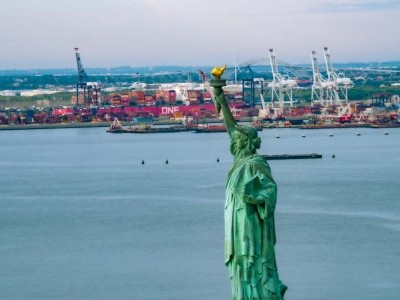Port of Long Beach Achieves Clean Air Goals
Oct 02, 2020A newly completed study of air pollution at the Port of Long Beach has found reduced diesel soot — down 88% since 2005 — and lower emissions of greenhouse gases, which have dropped 19%.
The Port’s annual emissions inventory report, presented to the Long Beach Board of Harbor Commissioners on Thursday, shows the Port continued to demonstrate low levels of emissions for diesel particulates and sulfur oxides in 2019 despite containerized cargo at the Port of Long Beach growing 14% since 2005.
According to the 2019 inventory, diesel particulates have decreased 88%. Sulfur oxides are down 97%, while smog-forming nitrogen oxides have decreased 58%. Greenhouse gas emissions reductions were 19%. The pollution levels are all compared to the 2005 baseline, the year before the original San Pedro Bay Clean Air Action Plan (CAAP) was adopted.
“Together with our supply chain partners, we have made significant progress in improving air quality and reducing health risks,” said Long Beach Harbor Commission President Frank Colonna. “Although we are meeting most of our emissions goals, it is becoming clear we are at the limits of existing technology. That’s why we are investing millions to develop and deploy the cleaner equipment.”
The CAAP was last updated in 2017 and incorporates numerous strategies to continue to reduce emissions from port-related operations in San Pedro Bay. The Port is making a significant investment into developing and demonstrating the first-of-its-kind, zero-emissions equipment through the Technology Advancement Program, and other grant-funded projects, to support future wide-scale deployment. The Port is currently implementing demonstration projects that will test 60 different pieces of zero-emissions equipment. Approximately 15% the cargo-handling fleet at the Port is already zero emissions today.
“Right now, we have $150 million in projects all across our port, all in the name of cleaner air,” said Port of Long Beach Executive Director Mario Cordero. “We are aggressively pursuing the CAAP goals of having a zero-emissions cargo-handling fleet by 2030 and all zero-emissions drayage trucks by 2035.”
The annual emissions inventory is reviewed by the U.S. Environmental Protection Agency, California Air Resources Board and South Coast Air Quality Management District. Learn more about the Port’s emissions inventories here.
The Port of Long Beach is one of the world’s premier seaports, a gateway for trans-Pacific trade and a trailblazer in goods movement and environmental stewardship. With 175 shipping lines connecting Long Beach to 217 seaports, the Port handles $170 billion in trade annually, supporting more than 575,000 Southern California jobs.
Similar Stories

Strike updates on Canada’s West Coast and Port of Montreal
View ArticlePorts awarded more than half a billion in MARAD PIDP Grants
The $580 million in grants awarded today range in size from more than $53 million for the Port of San Juan Puerto Rico to restore key wharves to $708,750 for…
View Article
Port of Hamburg: Sustained growth in hinterland transports
View Article
Port of Hueneme and Port of Paita sign MoU to establish a sister port relationship
View Article
New electric yard truck helps Port of Tacoma demonstrate zero-emission technology
View Article
Port Authority of NYNJ proposes $9.4 billion budget for 2025
View ArticleGet the most up-to-date trending news!
SubscribeIndustry updates and weekly newsletter direct to your inbox!





